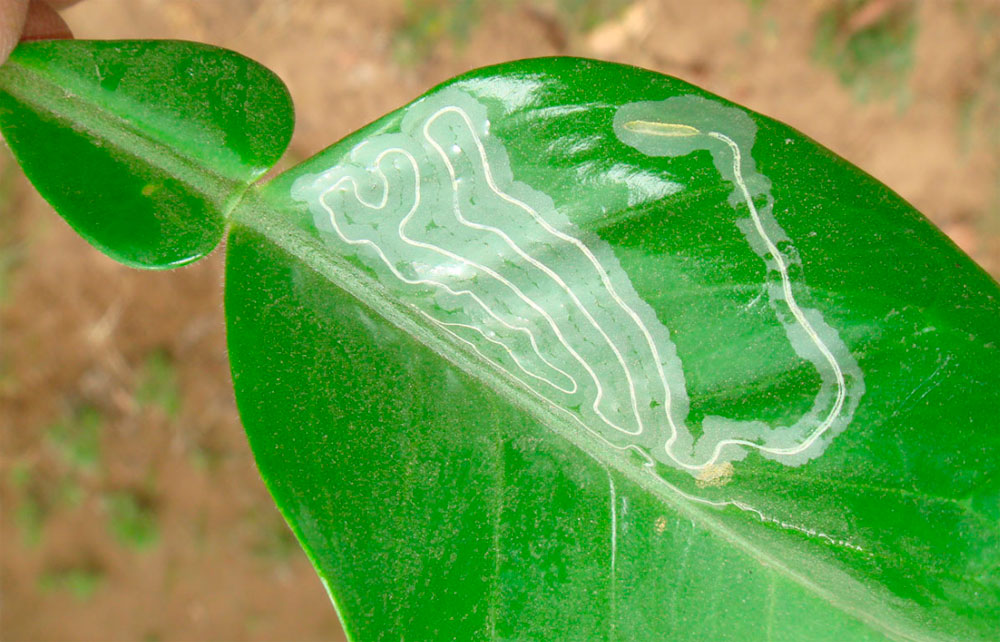
Miners
Phyllocnistis Citrella, Liriomyza Sp., Lyonetia Sp.
Pathogen:
Insect
Type:
Risk:
HIGH
Minadores
Plantas decorativas de jardín y/o interior


WHO CAUSES IT?
Phyllocnistis citrella, Liriomyza sp. and Lyonetia sp. They are genera of leafmining insects, known for their ability to infest various plants. These insects have a complex life cycle that involves several stages. Adult females lay their eggs on the surface or within the tissues of the leaves. Once the larvae emerge, they begin feeding on the inner tissue of the leaf, creating meandering galleries visible on the surface. The larvae go through several molts as they feed and grow inside the leaf. Upon reaching maturity, the larvae pupate inside the leaf or in the surrounding soil. The adults emerge from the pupae, ready to reproduce and continue the cycle. This process can be repeated several times a year, especially in warm climates, allowing leafminer populations to increase rapidly.
SYMPTOMS
The disease caused by leafminers on plants results in a series of characteristic symptoms due to the larvae feeding on leaf tissues. This not only reduces the photosynthetic capacity of plants, but also weakens them and makes them more susceptible to other diseases and environmental stresses.
- Appearance of serpentine and translucent galleries in the leaves.
- Discoloration and yellowing of affected leaves.
- Premature fall of severely damaged leaves.
- Reduction in the general vigor of the plant.
- Black or brown Taches on the leaves, indicative of larval feeding areas.
- Curling and deformation of the leaves.
- Presence of pupae on the lower surface of the leaves or on the nearby soil.



TEMPERATURE AND HUMIDITY
20°C a 30°C
60% a 80%
TRANSMISSION ROUTES
Direct contact between plants, Wind, Contaminated tools, Transport of infested plants, Contaminated soil
Do you want to remove this pest? Choose how you want to treat it.
TREATMENTS
Chemical treatments
• ACETAMIPRID 20% [SG] P/P
• ACETAMIPRID 20% [SP] P/P
• AZADIRACTIN 1% (AS AZADIRACTIN A) [EC] P/V
• Azadirachtin 2.6% (AS AZADIRACTIN A) [EC] P/V
• DELTAMETHRIN 1.57% [SC] P/V
• DELTAMETHRIN 10% [EC] P/V
• DELTAMETHRIN 2.5% [EC] P/V
• DELTAMETHRIN 2.5% [EW] P/V
• LAMBDA CYHALOTHRIN 1.5% [CS] P/V
• LAMBDA CYHALOTHRIN 10% [CS] P/V
• LAMBDA CYHALOTHRIN 2.5% [WG] P/P
• LAMBDA CYHALOTHRIN 5% [EG] P/P
• MILBEMECTIN 0.93% [EC] P/V
• Phyllocnistis citrella (Pheromone)
Authorized treatments in organic farming
• AZADIRACTIN 1% (AS AZADIRACTIN A) [EC] P/V
• Azadirachtin 2.6% (AS AZADIRACTIN A) [EC] P/V
• LAMBDA CYHALOTHRIN 1.5% [CS] P/V
• LAMBDA CYHALOTHRIN 10% [CS] P/V
• LAMBDA CYHALOTHRIN 2.5% [WG] P/P
• LAMBDA CYHALOTHRIN 5% [EG] P/P
• Phyllocnistis citrella (Pheromone)
Biological control
• BACILLUS THURINGIENSIS AIZAWAI (STRAIN GC-91) 50% (3.05 X 10^13 SPORES/KG) [WP] P/P
• BACILLUS THURINGIENSIS AIZAWAI 50% [WG] P/P
• BACILLUS THURINGIENSIS KURSTAKI (Strain EG 2348) 22.6% (24 x 10E6 UI/g) [SC] P/V
• BACILLUS THURINGIENSIS KURSTAKI (Strain SA-11) 85% (32 MILLION IU/G) [WG] P/P
• BACILLUS THURINGIENSIS KURSTAKI (EG 2348) (24x106 I.U./G) 18.3% [SC] P/V
• BACILLUS THURINGIENSIS KURSTAKI (EG 2348) 37.5% [WP] P/P
Recommendations
- Regularly inspect plants for early signs of infestation and manually remove affected leaves.
- Use yellow sticky traps to monitor and reduce the adult population.
- Apply specific insecticides for leafminers, following the manufacturer's recommendations and alternating products to avoid the development of resistance.
- Introduce and encourage the presence of natural enemies of leafminers, such as parasitoids and predators, which help control larval populations.
- Maintain adequate hygiene in the growing area, removing and destroying plant remains that may harbor pupae or adults.
- Avoid excessive use of nitrogen fertilizers, as they can promote the growth of tender shoots that are more susceptible to attack by leafminers.
- Implement cultivation practices that strengthen plant health, such as adequate irrigation and selective pruning.
Sponsored link
Sponsored link
Sponsored link
Sponsored link
Sponsored link
Sponsored link
Effective against all types of fungi
TREATMENTS
Homemade remedies
There are no home treatments
Natural allies
Chemical treatments
There are no treatments for this disease. Treatments are directed at the insect vectors that transmit it. See insect treatments.
RECOMMENDATIONS
- Check the back of the leaves frequently, especially in dry weather.
- Spray water on the leaves to increase humidity and prevent them from settling.
- Keep plants healthy with good watering and adequate light.
- If you see cobwebs or damage, clean the leaves with a damp cloth or pressurized water.
- Use potassium soap or neem oil every few days until they disappear.
REPELLENT PLANTS
Rosemary, Dill, Coriander
EFFECTIVE PRODUCTS TO ELIMINATE THIS PEST
Sponsored link
Sponsored link
Sponsored link
Sponsored link
Sponsored link
Sponsored link
Effective against all types of fungi
*The recommended treatments are recommendations based on the authorities' databases and do not replace in any way the guidelines established by the legislation of each country.
*Products shown are recommendations and not our own products. As Amazon Associates, we earn revenue from purchases of recommended products.






















